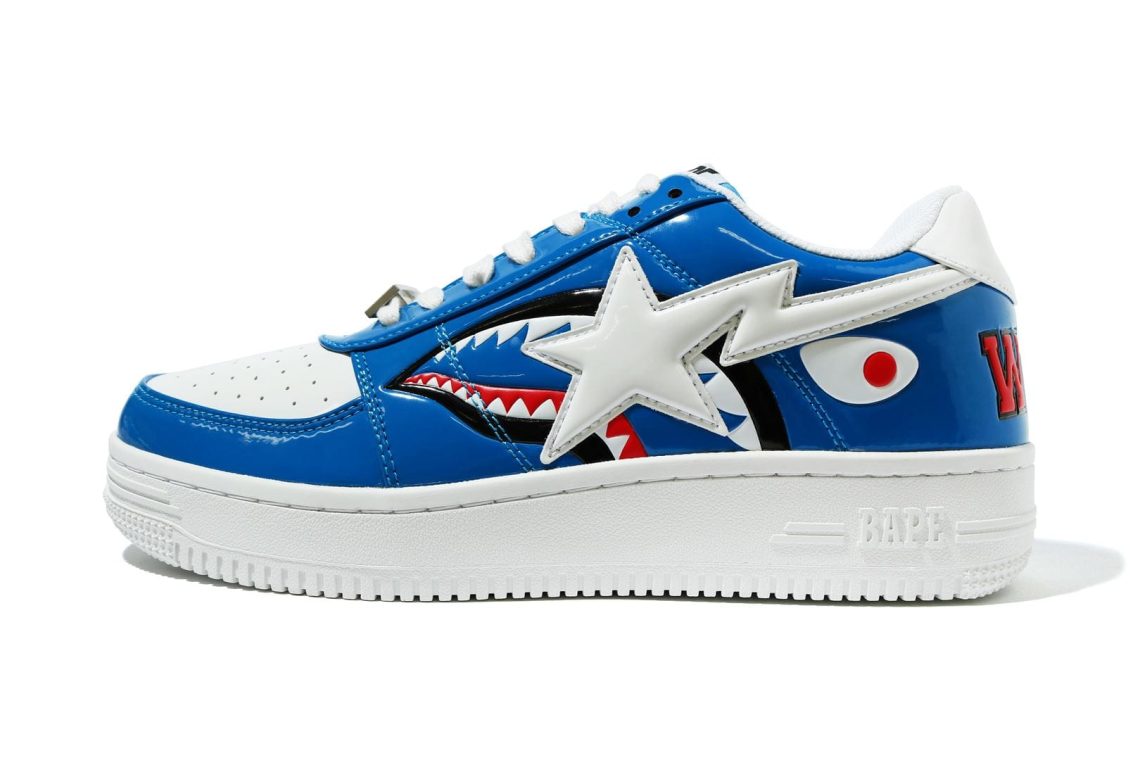The BAPESTA sneaker has emerged as a cornerstone of global streetwear culture, transcending its Japanese origins to achieve worldwide recognition. Created by NIGO in 2002 under the A Bathing Ape (BAPE) brand, the BAPESTA silhouette is renowned for its star-studded design, glossy patent leather finish, and undeniable resemblance to the Nike Air Force 1. More than a fashion statement, BAPESTA became a cultural artifact—fueled by celebrity influence, hip-hop validation, and an unwavering commitment to limited-edition style. The story of BAPESTA is not only a story about sneakers, but about how counterculture can reshape mainstream fashion narratives.
The Rise of BAPESTA in the Early 2000s
In the early 2000s, streetwear was undergoing a seismic shift. The underground culture of Tokyo’s Harajuku district began infiltrating Western fashion spheres. NIGO’s BAPE stood at the forefront of this transition, and the BAPESTA became its most recognizable weapon. Its instantly recognizable star logo—called the “STA”—was a rebellious twist on traditional branding, signaling a new generation of sneakerheads who wanted more than just comfort and performance. They wanted storytelling, exclusivity, and connection. BAPESTA delivered all of that and more.
Design Aesthetic and Signature Elements
What made BAPESTA instantly stand out was its unapologetic boldness. The sneakers often featured loud colorways, high-gloss patent leather, and unconventional designs that ranged from camouflage patterns to cartoon-inspired graphics. The lightning bolt star logo replaced Nike’s swoosh, turning the familiar into something subversively fresh. Each pair was a work of art—crafted not just for walking, but for making a statement. The use of premium materials and daring hues cemented BAPESTA’s place in both fashion runways and inner-city sidewalks.
Celebrity Endorsements and Pop Culture Integration
BAPESTA’s visibility soared as hip-hop artists and celebrities began championing the brand. Pharrell Williams, Kanye West, Soulja Boy, and Lil Wayne were all photographed wearing BAPESTAs, helping catapult the shoe into American popular culture. Kanye’s collaboration with BAPE, which featured his own BAPESTA design, remains one of the most iconic releases of the 2000s. These high-profile endorsements turned BAPESTA into more than just footwear—they became status symbols, collectibles, and urban fashion staples.
BAPESTA vs Air Force 1: The Controversial Comparison
The comparison between BAPESTA and Nike’s Air Force 1 has long been a subject of debate. While the two share a nearly identical silhouette, BAPESTA stands apart through its materials, branding, and cultural approach. Where the Air Force 1 plays into the athletic and utilitarian market, BAPESTA is an exercise in visual excess and streetwear storytelling. Over time, the legal concerns faded into the background as BAPESTA carved out its own identity—thanks to its limited releases and distinct artistic flair.
Global Expansion and Limited Edition Craze
As BAPE gained traction globally, BAPESTA’s international demand skyrocketed. The sneaker began appearing in exclusive boutiques in New York, London, and Paris. What fueled its desirability even more was the scarcity of each release. Limited-edition colorways and regional exclusives turned every drop into an event. Fans lined up for hours to get their hands on a pair, making BAPESTA an early innovator in the hype-driven sneaker economy. Resale markets flourished, with rare pairs fetching thousands of dollars.
Collaborations That Defined a Generation
One of BAPESTA’s strengths has always been its ability to collaborate across genres and industries. From iconic musicians to global brands like Marvel, Coca-Cola, and Hello Kitty, BAPESTA found ways to evolve while retaining its authenticity. Each collaboration injected fresh energy into the brand while preserving its core DNA. These crossovers also broadened its audience—bringing in not just sneakerheads, but pop culture enthusiasts, collectors, and fashion-forward consumers who valued uniqueness over conformity.
The Resurgence of BAPESTA in Modern Streetwear
After a few quieter years during the 2010s, BAPESTA made a major comeback as the streetwear revival took hold. The rise of vintage fashion, nostalgia, and archival releases led to a renewed appreciation for early BAPE designs. With NIGO’s continued influence in fashion through his work with Human Made and Kenzo, interest in BAPESTA surged once again. Re-releases of classic colorways, modern reinterpretations, and digital campaigns targeting Gen Z cemented BAPESTA’s position as a timeless force.
Why BAPESTA Still Matters in Sneaker Culture Today
In today’s oversaturated sneaker market, where daily drops and collaborations have become the norm, BAPESTA maintains its relevance by doing what it has always done best—pushing boundaries. It does not conform to seasonal trends or market analytics. Instead, it relies on bold creativity, limited availability, and cultural credibility. For collectors and fashion purists alike, BAPESTA offers a tangible connection to the early days of modern streetwear—when sneakers were more about personal identity than corporate influence.
Conclusion: The Timeless Influence of BAPESTA
BAPESTA is not just a sneaker—it is a movement rooted in rebellion, art, music, and fashion. From the streets of Tokyo to global fashion capitals, its legacy has only grown stronger. Its journey from underground cult favorite to internationally recognized icon shows the power of cultural authenticity and creative risk-taking.





